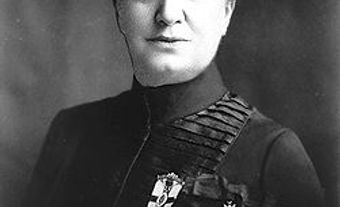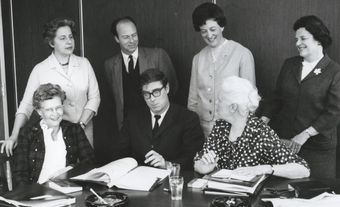Emily Murphy (née Ferguson, pen name Janey Canuck), writer, journalist, magistrate, political and legal reformer (born 14 March 1868 in Cookstown, ON; died 27 October 1933 in Edmonton, AB). Emily Murphy was the first woman magistrate in the British Empire. She was also one of the Famous Five behind the Persons Case, the successful campaign to have women declared persons in the eyes of British law. A self-described rebel, she was an outspoken feminist and suffragist and a controversial figure. Her views on immigration and eugenics have been criticized as racist and elitist. She was named a Person of National Historic Significance in 1958 and an honorary senator in 2009.

Family
Emily Murphy was born into a prominent Ontario family. She had relatives in business, politics and the law, including two Supreme Court justices. Her maternal grandfather was politician and newspaper owner Ogle R. Gowan. He founded the first Orange Order lodge in Canada in 1830. Murphy therefore grew up in a family that frequently discussed legal and political matters.
She attended the prestigious Bishop Strachan School, a private Anglican girls’ school in Toronto. While in Toronto, she met Arthur Murphy, a theology student whom she later married. Murphy moved west in 1903 to Swan River, Manitoba, with her husband, now an Anglican minister and entrepreneur, and their two daughters. In 1907, the family moved to Edmonton, Alberta.
Author and Activist
Emily Murphy was a prolific contributor of book reviews and articles to Canadian magazines and newspapers. She adopted the pen name Janey Canuck and published four very popular books of personal sketches: The Impressions of Janey Canuck Abroad (1901); Janey Canuck in the West (1910); Open Trails (1912); and Seeds of Pine (1914).
Murphy combined family life, writing and a multitude of reform activities in the interests of women and children. This included women’s property rights. While travelling through the Alberta countryside, Murphy met a woman who had been abandoned by her husband; the man had sold their farm and left her without a home or money. Legally, the woman had no rights to the property. Incensed, Murphy began a campaign to protect women’s property rights. In 1915, the Alberta legislature passed the Married Woman’s Home Protection Act. This gave women the right to file a caveat; this prevented the transfer, mortgage or lease of a woman’s home without her consent. In 1917, this was replaced by the Dower Act. (See also Dower.) It protected a wife’s right to a one-third share in her husband’s property.
Murphy was also prominent in the suffrage movement. She was a long-time executive member of the Canadian Women's Press Club (president 1913–20), the National Council of Women of Canada, the Federated Women’s Institutes of Canada (first national president) and more than 20 other professional and volunteer organizations.
First Woman Magistrate
Emily Murphy's career took an unexpected turn in 1916. In March of that year, members of the Edmonton Local Council of Women tried to attend the trial of several women who had been arrested as prostitutes. The women were ejected from the court on the grounds that the testimony was “not fit for mixed company.” Murphy was outraged, and protested to the provincial Attorney General.
“If the evidence is not fit to be heard in mixed company,” she argued, “then ... the government … [must] set up a special court presided over by women, to try other women.” To her surprise, the Minister agreed. He offered Murphy the post of presiding over such a court.
Murphy accepted the offer. In 1916, she was appointed police magistrate for Edmonton and then Alberta. She was the first woman magistrate in the British Empire. Exposed to a succession of cases involving prostitution and juvenile offenders, she became an implacable opponent of narcotics. She blamed it for organized crime and for victimizing the defenceless.
The Black Candle (1922)
The Black Candle (1922) by “Judge Murphy” was an expansion of articles published in Maclean's magazine describing in lurid detail the evils of the drug trade. Murphy’s exposé led to laws governing narcotics that remained unchanged until the late 1960s.
In the book, Murphy discusses the involvement of Chinese, Assyrians, Greeks and “Negroes” in the drug trade. (See also Iranian Canadians; Black Canadians.) At the time, there was considerable concern about immigration, particularly Chinese immigration, in Western Canada. (See Chinese Head Tax in Canada.) Murphy’s comments likely reflected and contributed to these concerns.
Scholars continue to debate Murphy’s beliefs about race and immigration. Some condemn her for racist and imperial views. Others argue that her main concern was the drug trade itself and that any discussion of her beliefs should also consider the systemic (or widespread) racism of the time.
The Persons Case
Emily Murphy is best known as a suffragist, and particularly for her role in the famous Persons Case. On her first day as a magistrate, she was challenged by a lawyer; he asserted that as a woman she was not a person in the eyes of British law. At the time, women were not included in the definition of persons under the Constitution. This led Murphy to embark on a decade-long campaign to have women declared legal persons.
In August 1927, she invited Henrietta Muir Edwards, Irene Parlby, Louise McKinney and Nellie McClung to a meeting at her Edmonton home. Murphy had carefully drafted a petition to put before the Supreme Court of Canada regarding the interpretation of the word persons in the British North America Act(now called the Constitution Act, 1867).
Murphy and the others signed the petition. Edwards’s signature appeared first; thus, the case was titled Edwards v. Attorney General of Canada. The petition asked the Supreme Court whether the word persons in Section 24 of the British North America Act, 1867 included women. If it considered women to be persons, the Constitution would allow for a woman to be appointed to the Senate.
Handing down the judgment on 24 April 1928, the Supreme Court denied the petition. The women — first called the “Alberta Five” and later the “Famous Five” — took their request to the Judicial Committee of the Privy Council in England (Canada’s highest court of appeal until 1949).
On 18 October 1929, after much deliberation, the Privy Council reversed the decision of the Supreme Court. It concluded that “the word ‘persons’ in sec. 24 does include women, and that women are eligible to be summoned to and become members of the Senate of Canada.” Lord Sankey, who delivered the judgement on behalf of the Privy Council in what became known as the Persons Case, also remarked that the “exclusion of women from all public offices is a relic of days more barbarous than ours […] and to those who ask why the word [persons] should include females, the obvious answer is why should it not.”
Following the Privy Council decision, women were eligible for Senate appointments. But the long-sought Senate appointment eluded Murphy. She died of diabetes in 1933. (See also Emily Murphy’s Famous Triumph.)
Eugenics
Like other members of the Famous Five, Emily Murphy has been criticized as being elitist and racist. In addition to her concerns about immigration, she also supported the eugenics movement. Eugenics was a pseudoscience that subscribed to the idea that the human population could be improved by controlling reproduction. Many influential Canadians, including J. S. Woodsworth, Dr. Clarence Hincks and Tommy Douglas, supported eugenic ideas in the early 1900s. (See also Tommy Douglas and Eugenics.) They promoted both “positive” eugenics (promoting the breeding of “fit” members of society) and “negative” eugenics (discouraging procreation by those considered “unfit”). Eugenicists argued that “mental defectives” and the “feeble-minded” were prone to alcoholism, promiscuity, mental illness, delinquency and criminal behaviour, and therefore posed a threat to the moral fabric of the community. These concerns led to increasing support for eugenic legislation, including the sterilization of “defectives.”
Like several other early feminists, including Nellie McClung, Murphy publicly supported negative eugenics. According to sociologist Jana Grekul, Murphy warned that the unfit were “becoming vastly more populous than those we designate as the ‘upper crust.’ This is why it is altogether likely that the upper crust with its delicious plums and dash of cream is likely to become at any time a mere toothsome morsel for the hungry, the abnormal, the criminals and the posterity of insane paupers.”
As a judge, Murphy had considerable influence in Alberta. Her public support of eugenic policies likely contributed to the passage of Alberta’s Sexual Sterilization Act in 1928. The Act led to the forced sterilization of people considered “mentally deficient.” A disproportionate number of them were Indigenous women. (See also Sterilization of Indigenous Women in Canada.) The Act was not repealed until 1972. During that time, thousands of people who were considered “psychotic” or “mentally defective” underwent forced sterilization.
Legacy
Emily Murphy was named a Person of National Historic Significance by the Government of Canada in 1958. In October 2009, 80 years after the Persons Case, the Senate voted to recognize the Famous Five as honorary senators. It was the first time the Senate had bestowed such a distinction.
See also Women’s Movements in Canada; Status of Women; Royal Commission on the Status of Women in Canada; Council on the Status of Women; Women and the Law; Women’s Organizations.

 Share on Facebook
Share on Facebook Share on X
Share on X Share by Email
Share by Email Share on Google Classroom
Share on Google Classroom




